Organizational Behavior: B&Q Structure and Leadership Analysis
VerifiedAdded on 2020/01/28
|12
|4060
|67
Report
AI Summary
This report provides a comprehensive analysis of organizational behavior at B&Q, examining its current culture and structure, and comparing it to other organizations like Tesco. It delves into the effectiveness of B&Q's leadership and management styles, highlighting the use of both authoritarian and participative approaches, and how these styles are supported by organizational theories such as scientific management. The report explores various leadership and management theories, including the Great Man Theory and Theory X and Y, and their application within B&Q. Furthermore, it investigates the impact of leadership styles on workforce motivation, comparing the effects of different motivational theories, such as Maslow's hierarchy of needs and Herzberg's two-factor theory. Finally, the report assesses the nature of groups and teamwork in organizations, identifying factors that can either help or hinder effective teamwork at B&Q, and evaluating the impact of technology on team functioning, including suggestions for how technology can further promote team effectiveness.
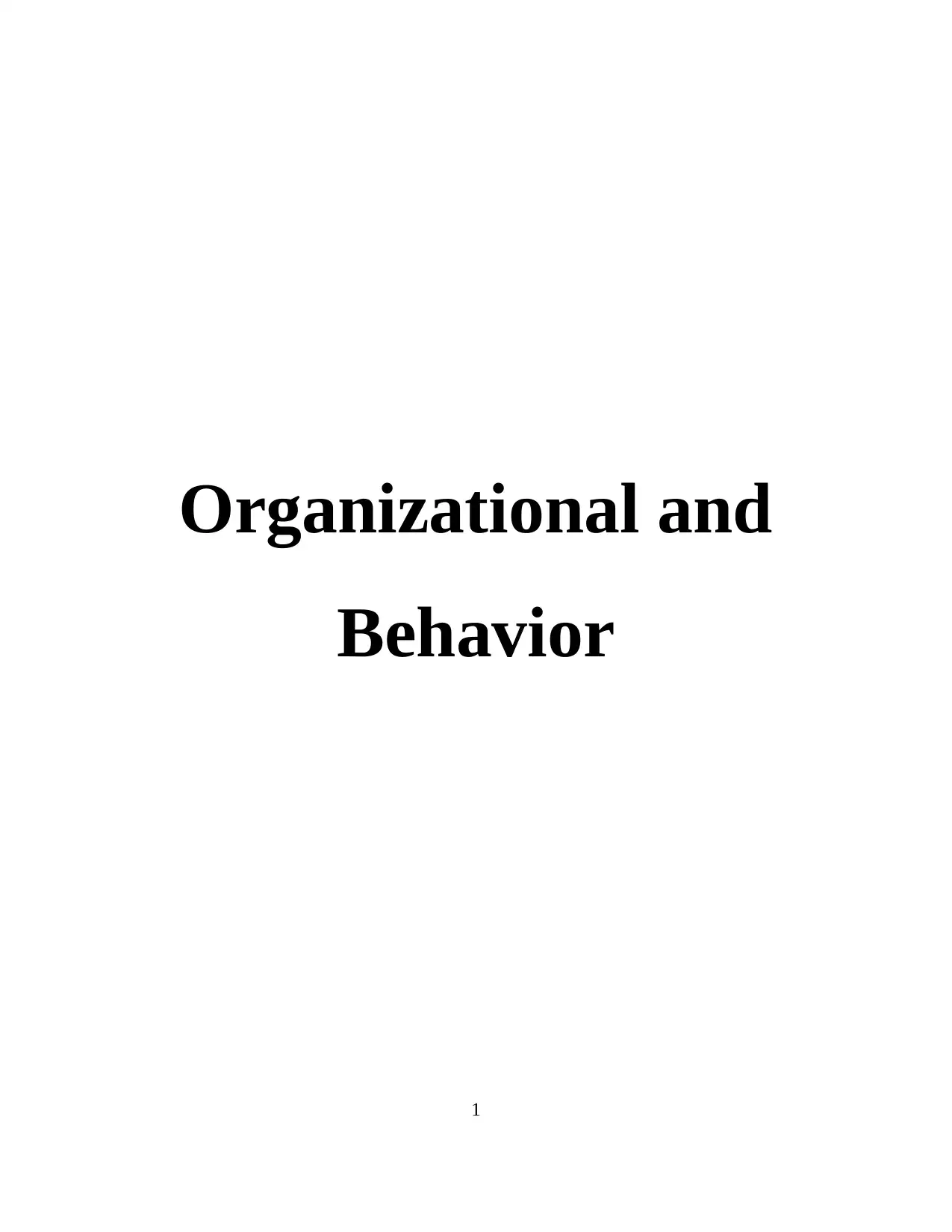
Organizational and
Behavior
1
Behavior
1
Paraphrase This Document
Need a fresh take? Get an instant paraphrase of this document with our AI Paraphraser
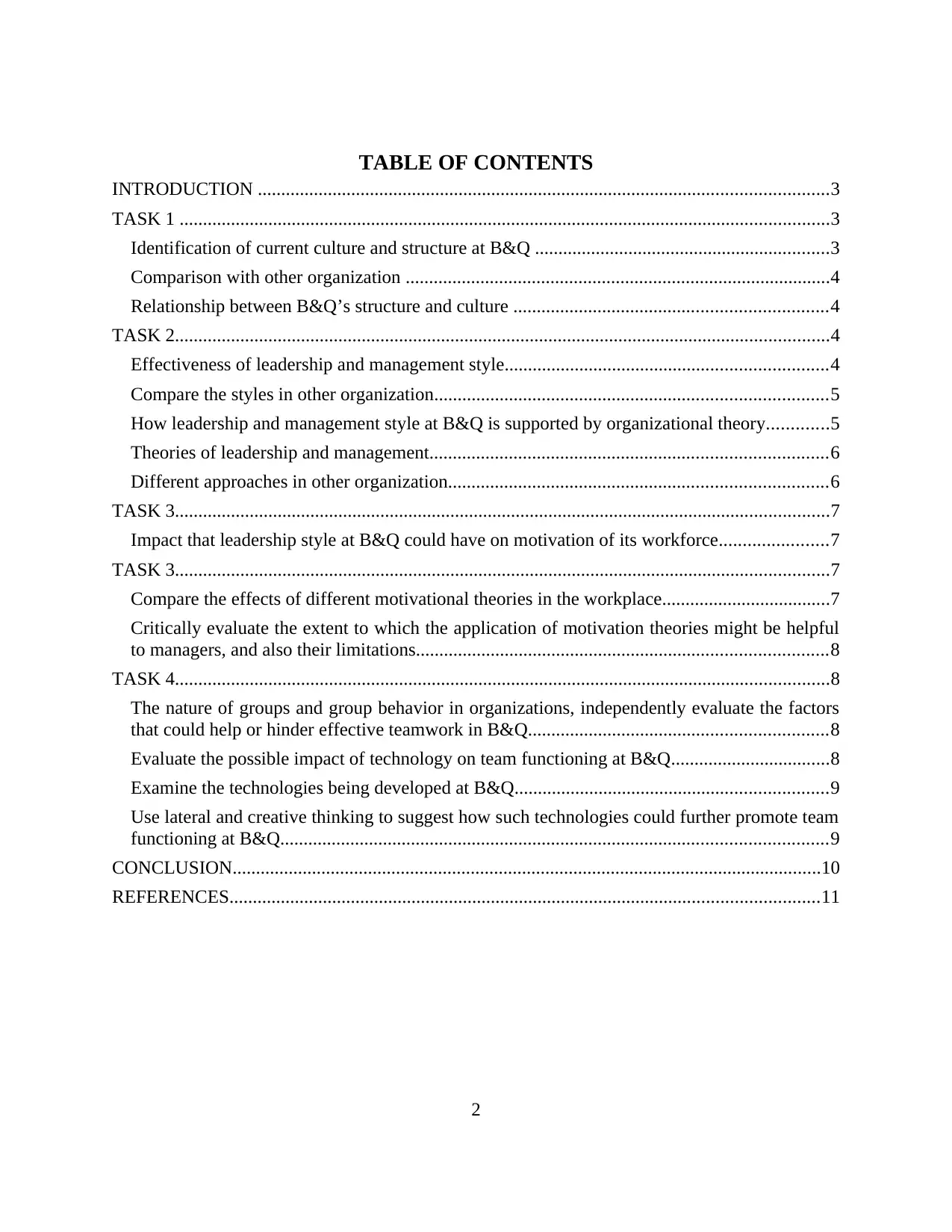
TABLE OF CONTENTS
INTRODUCTION ..........................................................................................................................3
TASK 1 ...........................................................................................................................................3
Identification of current culture and structure at B&Q ...............................................................3
Comparison with other organization ...........................................................................................4
Relationship between B&Q’s structure and culture ...................................................................4
TASK 2............................................................................................................................................4
Effectiveness of leadership and management style.....................................................................4
Compare the styles in other organization....................................................................................5
How leadership and management style at B&Q is supported by organizational theory.............5
Theories of leadership and management.....................................................................................6
Different approaches in other organization.................................................................................6
TASK 3............................................................................................................................................7
Impact that leadership style at B&Q could have on motivation of its workforce.......................7
TASK 3............................................................................................................................................7
Compare the effects of different motivational theories in the workplace....................................7
Critically evaluate the extent to which the application of motivation theories might be helpful
to managers, and also their limitations........................................................................................8
TASK 4............................................................................................................................................8
The nature of groups and group behavior in organizations, independently evaluate the factors
that could help or hinder effective teamwork in B&Q................................................................8
Evaluate the possible impact of technology on team functioning at B&Q..................................8
Examine the technologies being developed at B&Q...................................................................9
Use lateral and creative thinking to suggest how such technologies could further promote team
functioning at B&Q.....................................................................................................................9
CONCLUSION..............................................................................................................................10
REFERENCES..............................................................................................................................11
2
INTRODUCTION ..........................................................................................................................3
TASK 1 ...........................................................................................................................................3
Identification of current culture and structure at B&Q ...............................................................3
Comparison with other organization ...........................................................................................4
Relationship between B&Q’s structure and culture ...................................................................4
TASK 2............................................................................................................................................4
Effectiveness of leadership and management style.....................................................................4
Compare the styles in other organization....................................................................................5
How leadership and management style at B&Q is supported by organizational theory.............5
Theories of leadership and management.....................................................................................6
Different approaches in other organization.................................................................................6
TASK 3............................................................................................................................................7
Impact that leadership style at B&Q could have on motivation of its workforce.......................7
TASK 3............................................................................................................................................7
Compare the effects of different motivational theories in the workplace....................................7
Critically evaluate the extent to which the application of motivation theories might be helpful
to managers, and also their limitations........................................................................................8
TASK 4............................................................................................................................................8
The nature of groups and group behavior in organizations, independently evaluate the factors
that could help or hinder effective teamwork in B&Q................................................................8
Evaluate the possible impact of technology on team functioning at B&Q..................................8
Examine the technologies being developed at B&Q...................................................................9
Use lateral and creative thinking to suggest how such technologies could further promote team
functioning at B&Q.....................................................................................................................9
CONCLUSION..............................................................................................................................10
REFERENCES..............................................................................................................................11
2
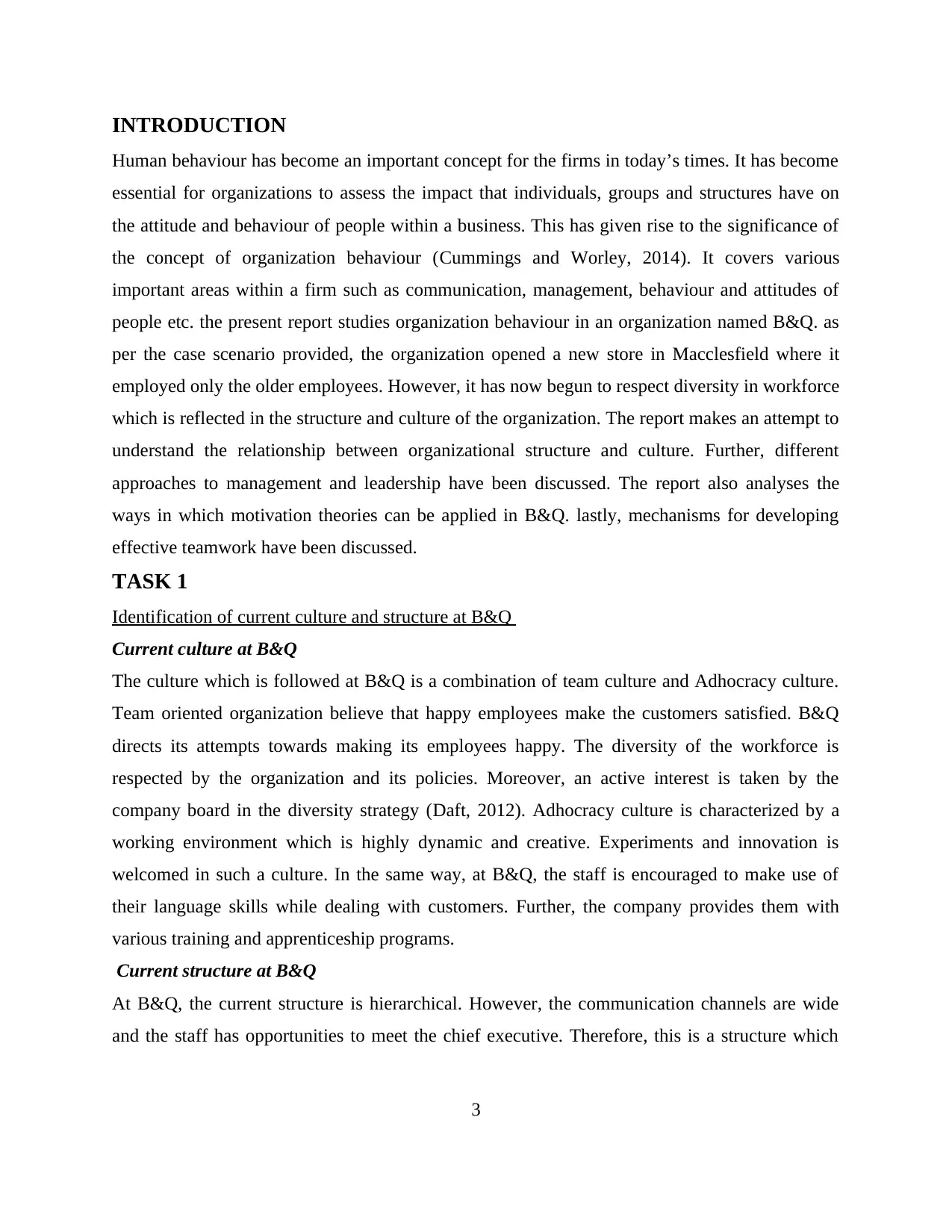
INTRODUCTION
Human behaviour has become an important concept for the firms in today’s times. It has become
essential for organizations to assess the impact that individuals, groups and structures have on
the attitude and behaviour of people within a business. This has given rise to the significance of
the concept of organization behaviour (Cummings and Worley, 2014). It covers various
important areas within a firm such as communication, management, behaviour and attitudes of
people etc. the present report studies organization behaviour in an organization named B&Q. as
per the case scenario provided, the organization opened a new store in Macclesfield where it
employed only the older employees. However, it has now begun to respect diversity in workforce
which is reflected in the structure and culture of the organization. The report makes an attempt to
understand the relationship between organizational structure and culture. Further, different
approaches to management and leadership have been discussed. The report also analyses the
ways in which motivation theories can be applied in B&Q. lastly, mechanisms for developing
effective teamwork have been discussed.
TASK 1
Identification of current culture and structure at B&Q
Current culture at B&Q
The culture which is followed at B&Q is a combination of team culture and Adhocracy culture.
Team oriented organization believe that happy employees make the customers satisfied. B&Q
directs its attempts towards making its employees happy. The diversity of the workforce is
respected by the organization and its policies. Moreover, an active interest is taken by the
company board in the diversity strategy (Daft, 2012). Adhocracy culture is characterized by a
working environment which is highly dynamic and creative. Experiments and innovation is
welcomed in such a culture. In the same way, at B&Q, the staff is encouraged to make use of
their language skills while dealing with customers. Further, the company provides them with
various training and apprenticeship programs.
Current structure at B&Q
At B&Q, the current structure is hierarchical. However, the communication channels are wide
and the staff has opportunities to meet the chief executive. Therefore, this is a structure which
3
Human behaviour has become an important concept for the firms in today’s times. It has become
essential for organizations to assess the impact that individuals, groups and structures have on
the attitude and behaviour of people within a business. This has given rise to the significance of
the concept of organization behaviour (Cummings and Worley, 2014). It covers various
important areas within a firm such as communication, management, behaviour and attitudes of
people etc. the present report studies organization behaviour in an organization named B&Q. as
per the case scenario provided, the organization opened a new store in Macclesfield where it
employed only the older employees. However, it has now begun to respect diversity in workforce
which is reflected in the structure and culture of the organization. The report makes an attempt to
understand the relationship between organizational structure and culture. Further, different
approaches to management and leadership have been discussed. The report also analyses the
ways in which motivation theories can be applied in B&Q. lastly, mechanisms for developing
effective teamwork have been discussed.
TASK 1
Identification of current culture and structure at B&Q
Current culture at B&Q
The culture which is followed at B&Q is a combination of team culture and Adhocracy culture.
Team oriented organization believe that happy employees make the customers satisfied. B&Q
directs its attempts towards making its employees happy. The diversity of the workforce is
respected by the organization and its policies. Moreover, an active interest is taken by the
company board in the diversity strategy (Daft, 2012). Adhocracy culture is characterized by a
working environment which is highly dynamic and creative. Experiments and innovation is
welcomed in such a culture. In the same way, at B&Q, the staff is encouraged to make use of
their language skills while dealing with customers. Further, the company provides them with
various training and apprenticeship programs.
Current structure at B&Q
At B&Q, the current structure is hierarchical. However, the communication channels are wide
and the staff has opportunities to meet the chief executive. Therefore, this is a structure which
3
⊘ This is a preview!⊘
Do you want full access?
Subscribe today to unlock all pages.

Trusted by 1+ million students worldwide
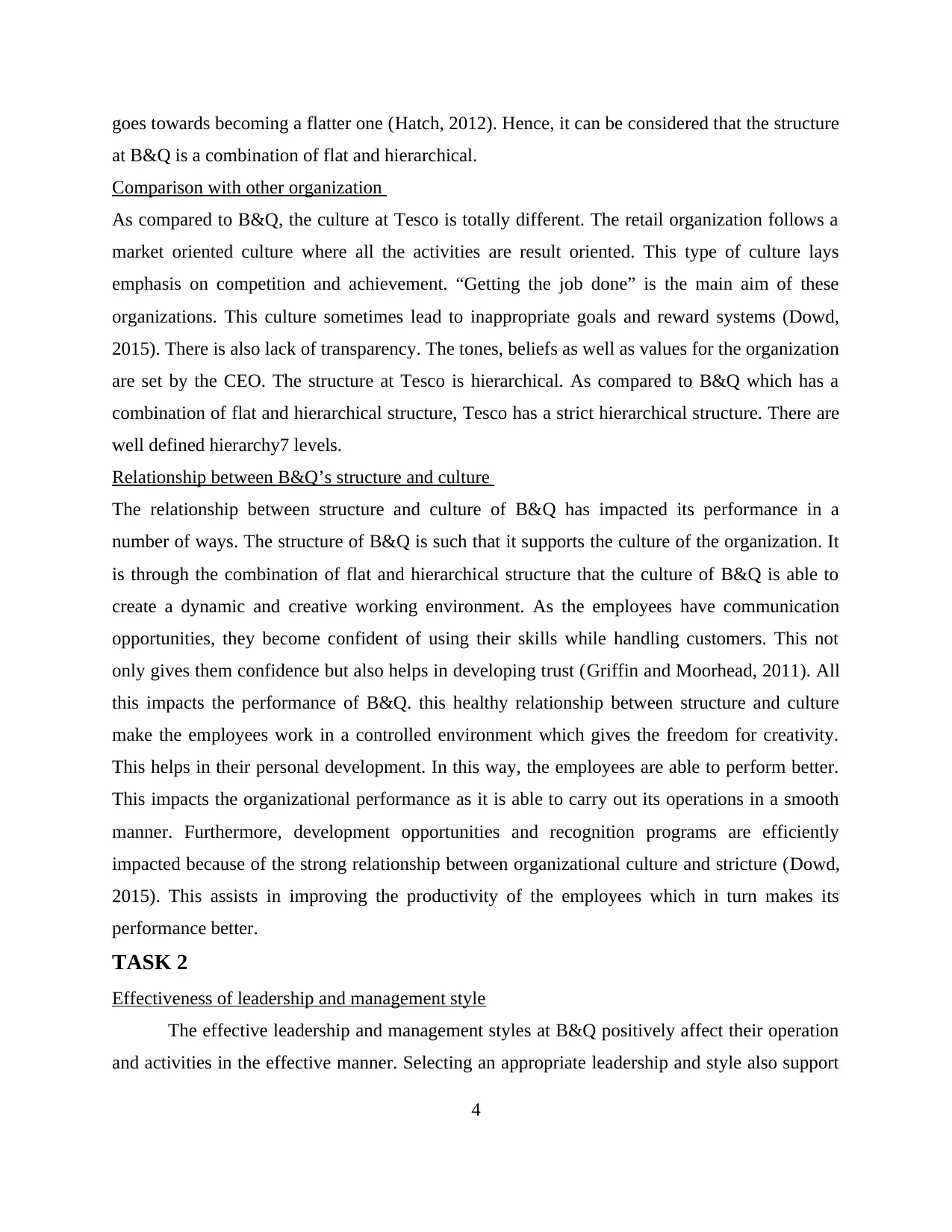
goes towards becoming a flatter one (Hatch, 2012). Hence, it can be considered that the structure
at B&Q is a combination of flat and hierarchical.
Comparison with other organization
As compared to B&Q, the culture at Tesco is totally different. The retail organization follows a
market oriented culture where all the activities are result oriented. This type of culture lays
emphasis on competition and achievement. “Getting the job done” is the main aim of these
organizations. This culture sometimes lead to inappropriate goals and reward systems (Dowd,
2015). There is also lack of transparency. The tones, beliefs as well as values for the organization
are set by the CEO. The structure at Tesco is hierarchical. As compared to B&Q which has a
combination of flat and hierarchical structure, Tesco has a strict hierarchical structure. There are
well defined hierarchy7 levels.
Relationship between B&Q’s structure and culture
The relationship between structure and culture of B&Q has impacted its performance in a
number of ways. The structure of B&Q is such that it supports the culture of the organization. It
is through the combination of flat and hierarchical structure that the culture of B&Q is able to
create a dynamic and creative working environment. As the employees have communication
opportunities, they become confident of using their skills while handling customers. This not
only gives them confidence but also helps in developing trust (Griffin and Moorhead, 2011). All
this impacts the performance of B&Q. this healthy relationship between structure and culture
make the employees work in a controlled environment which gives the freedom for creativity.
This helps in their personal development. In this way, the employees are able to perform better.
This impacts the organizational performance as it is able to carry out its operations in a smooth
manner. Furthermore, development opportunities and recognition programs are efficiently
impacted because of the strong relationship between organizational culture and stricture (Dowd,
2015). This assists in improving the productivity of the employees which in turn makes its
performance better.
TASK 2
Effectiveness of leadership and management style
The effective leadership and management styles at B&Q positively affect their operation
and activities in the effective manner. Selecting an appropriate leadership and style also support
4
at B&Q is a combination of flat and hierarchical.
Comparison with other organization
As compared to B&Q, the culture at Tesco is totally different. The retail organization follows a
market oriented culture where all the activities are result oriented. This type of culture lays
emphasis on competition and achievement. “Getting the job done” is the main aim of these
organizations. This culture sometimes lead to inappropriate goals and reward systems (Dowd,
2015). There is also lack of transparency. The tones, beliefs as well as values for the organization
are set by the CEO. The structure at Tesco is hierarchical. As compared to B&Q which has a
combination of flat and hierarchical structure, Tesco has a strict hierarchical structure. There are
well defined hierarchy7 levels.
Relationship between B&Q’s structure and culture
The relationship between structure and culture of B&Q has impacted its performance in a
number of ways. The structure of B&Q is such that it supports the culture of the organization. It
is through the combination of flat and hierarchical structure that the culture of B&Q is able to
create a dynamic and creative working environment. As the employees have communication
opportunities, they become confident of using their skills while handling customers. This not
only gives them confidence but also helps in developing trust (Griffin and Moorhead, 2011). All
this impacts the performance of B&Q. this healthy relationship between structure and culture
make the employees work in a controlled environment which gives the freedom for creativity.
This helps in their personal development. In this way, the employees are able to perform better.
This impacts the organizational performance as it is able to carry out its operations in a smooth
manner. Furthermore, development opportunities and recognition programs are efficiently
impacted because of the strong relationship between organizational culture and stricture (Dowd,
2015). This assists in improving the productivity of the employees which in turn makes its
performance better.
TASK 2
Effectiveness of leadership and management style
The effective leadership and management styles at B&Q positively affect their operation
and activities in the effective manner. Selecting an appropriate leadership and style also support
4
Paraphrase This Document
Need a fresh take? Get an instant paraphrase of this document with our AI Paraphraser
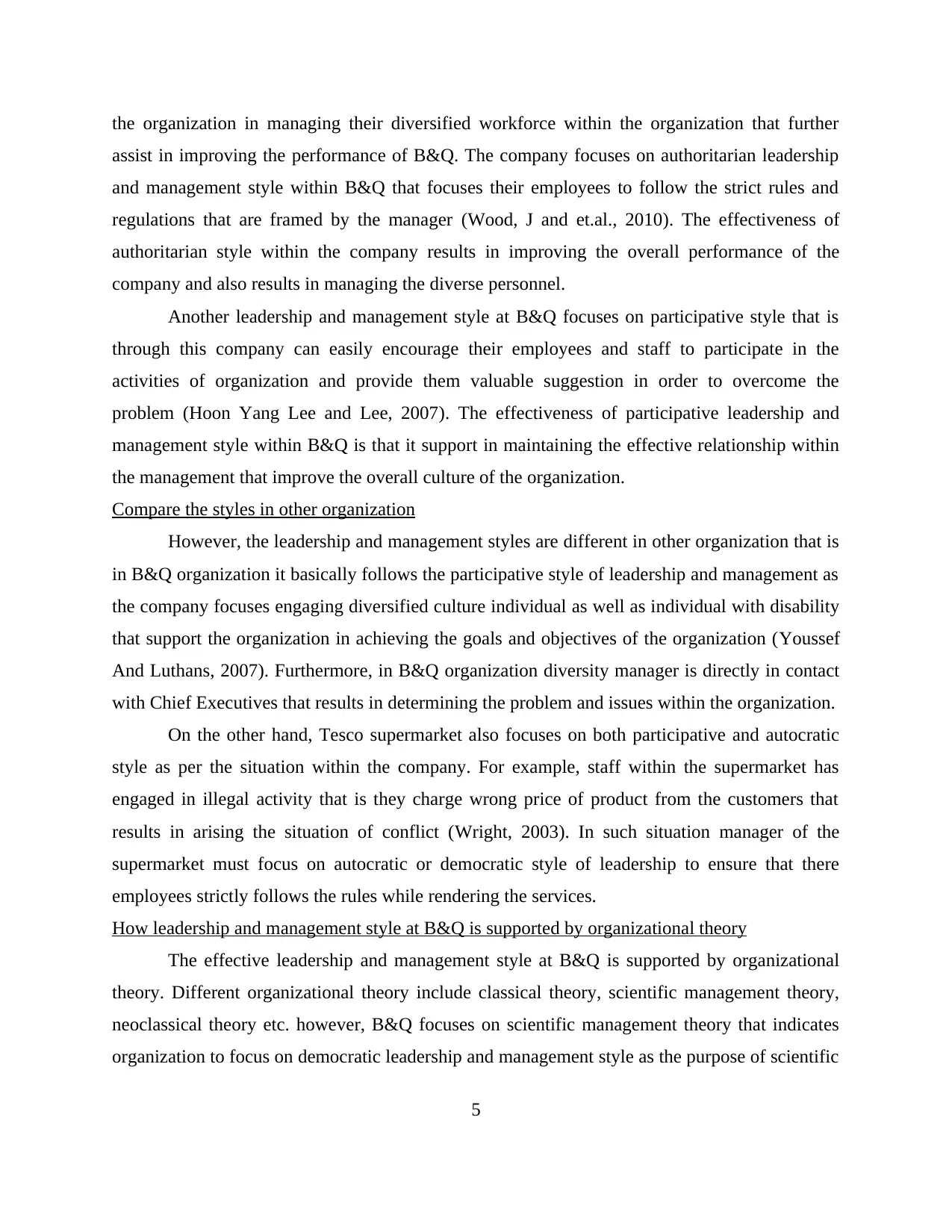
the organization in managing their diversified workforce within the organization that further
assist in improving the performance of B&Q. The company focuses on authoritarian leadership
and management style within B&Q that focuses their employees to follow the strict rules and
regulations that are framed by the manager (Wood, J and et.al., 2010). The effectiveness of
authoritarian style within the company results in improving the overall performance of the
company and also results in managing the diverse personnel.
Another leadership and management style at B&Q focuses on participative style that is
through this company can easily encourage their employees and staff to participate in the
activities of organization and provide them valuable suggestion in order to overcome the
problem (Hoon Yang Lee and Lee, 2007). The effectiveness of participative leadership and
management style within B&Q is that it support in maintaining the effective relationship within
the management that improve the overall culture of the organization.
Compare the styles in other organization
However, the leadership and management styles are different in other organization that is
in B&Q organization it basically follows the participative style of leadership and management as
the company focuses engaging diversified culture individual as well as individual with disability
that support the organization in achieving the goals and objectives of the organization (Youssef
And Luthans, 2007). Furthermore, in B&Q organization diversity manager is directly in contact
with Chief Executives that results in determining the problem and issues within the organization.
On the other hand, Tesco supermarket also focuses on both participative and autocratic
style as per the situation within the company. For example, staff within the supermarket has
engaged in illegal activity that is they charge wrong price of product from the customers that
results in arising the situation of conflict (Wright, 2003). In such situation manager of the
supermarket must focus on autocratic or democratic style of leadership to ensure that there
employees strictly follows the rules while rendering the services.
How leadership and management style at B&Q is supported by organizational theory
The effective leadership and management style at B&Q is supported by organizational
theory. Different organizational theory include classical theory, scientific management theory,
neoclassical theory etc. however, B&Q focuses on scientific management theory that indicates
organization to focus on democratic leadership and management style as the purpose of scientific
5
assist in improving the performance of B&Q. The company focuses on authoritarian leadership
and management style within B&Q that focuses their employees to follow the strict rules and
regulations that are framed by the manager (Wood, J and et.al., 2010). The effectiveness of
authoritarian style within the company results in improving the overall performance of the
company and also results in managing the diverse personnel.
Another leadership and management style at B&Q focuses on participative style that is
through this company can easily encourage their employees and staff to participate in the
activities of organization and provide them valuable suggestion in order to overcome the
problem (Hoon Yang Lee and Lee, 2007). The effectiveness of participative leadership and
management style within B&Q is that it support in maintaining the effective relationship within
the management that improve the overall culture of the organization.
Compare the styles in other organization
However, the leadership and management styles are different in other organization that is
in B&Q organization it basically follows the participative style of leadership and management as
the company focuses engaging diversified culture individual as well as individual with disability
that support the organization in achieving the goals and objectives of the organization (Youssef
And Luthans, 2007). Furthermore, in B&Q organization diversity manager is directly in contact
with Chief Executives that results in determining the problem and issues within the organization.
On the other hand, Tesco supermarket also focuses on both participative and autocratic
style as per the situation within the company. For example, staff within the supermarket has
engaged in illegal activity that is they charge wrong price of product from the customers that
results in arising the situation of conflict (Wright, 2003). In such situation manager of the
supermarket must focus on autocratic or democratic style of leadership to ensure that there
employees strictly follows the rules while rendering the services.
How leadership and management style at B&Q is supported by organizational theory
The effective leadership and management style at B&Q is supported by organizational
theory. Different organizational theory include classical theory, scientific management theory,
neoclassical theory etc. however, B&Q focuses on scientific management theory that indicates
organization to focus on democratic leadership and management style as the purpose of scientific
5

management theory is to improve productivity of labour (Leadership Theories, 2013). The
democratic leadership style is well supported with the organizational theory of the B&Q.
However, the leadership and management styles at B&Q mainly focuses on the
coordinating the activities of different and diverse employees those who are rendering services
within the organization (Wood, J and et.al., 2010). In addition to this, with the help of democratic
leadership and management styles it may also control the activities of staff and employees that
further reduces the issues in organization.
Theories of leadership and management
There are different theories of leadership and management that is being used within B&Q
organization include Great Man Theory under which leaders within the organization are inborn
leaders. The individual posses the qualities and characteristics of the effective leaders that assist
them to become the great leader (Hoon Yang, Lee and Lee, 2008). Furthermore, the theory also
assumes that attribute of the leadership in B&Q are intrinsic that is in-built.
On the other hand, the management theory generally focuses on theory X and Y that
mainly addresses the different strategies for motivating the employees and workforce within
B&Q that further support the employees in increasing their productivity (Green-Raleigh, K.,
Carter, H. and Petrini, J., 2006). Both the theories benefit the employees as well as organization.
Different approaches in other organization
However, the approaches of management and leadership differ from organization to
organization that is in B&Q organization it basically focuses on implementing scientific
management approach as its main aim is to improve and amend the productivity of employees
(Banki, 2010). However, the organization will focus on adopting democratic leadership to
improve the productivity of employees.
On the other hand, Tesco focuses on classical management approach within the
organization as this theory ensure organization as machine and manpower as the wheel that is
essential for running the machine (Robbins and et.al., 2013). Therefore, it focuses on
participative leadership approach under which Tesco manager focuses on taking reviews from
their staff members regarding improving the performance of organization.
6
democratic leadership style is well supported with the organizational theory of the B&Q.
However, the leadership and management styles at B&Q mainly focuses on the
coordinating the activities of different and diverse employees those who are rendering services
within the organization (Wood, J and et.al., 2010). In addition to this, with the help of democratic
leadership and management styles it may also control the activities of staff and employees that
further reduces the issues in organization.
Theories of leadership and management
There are different theories of leadership and management that is being used within B&Q
organization include Great Man Theory under which leaders within the organization are inborn
leaders. The individual posses the qualities and characteristics of the effective leaders that assist
them to become the great leader (Hoon Yang, Lee and Lee, 2008). Furthermore, the theory also
assumes that attribute of the leadership in B&Q are intrinsic that is in-built.
On the other hand, the management theory generally focuses on theory X and Y that
mainly addresses the different strategies for motivating the employees and workforce within
B&Q that further support the employees in increasing their productivity (Green-Raleigh, K.,
Carter, H. and Petrini, J., 2006). Both the theories benefit the employees as well as organization.
Different approaches in other organization
However, the approaches of management and leadership differ from organization to
organization that is in B&Q organization it basically focuses on implementing scientific
management approach as its main aim is to improve and amend the productivity of employees
(Banki, 2010). However, the organization will focus on adopting democratic leadership to
improve the productivity of employees.
On the other hand, Tesco focuses on classical management approach within the
organization as this theory ensure organization as machine and manpower as the wheel that is
essential for running the machine (Robbins and et.al., 2013). Therefore, it focuses on
participative leadership approach under which Tesco manager focuses on taking reviews from
their staff members regarding improving the performance of organization.
6
⊘ This is a preview!⊘
Do you want full access?
Subscribe today to unlock all pages.

Trusted by 1+ million students worldwide

TASK 3
Impact that leadership style at B&Q could have on motivation of its workforce
However, the different leadership styles such as participative, democratic and laissez-
faire have positively impact on motivating the workforce of B&Q. For instance; through
adopting participative leadership style within the organization it will benefit the employees in
providing their views and thoughts in the organization so that they can attain sense of
belongingness towards the organization (Leadership Theories, 2013). Furthermore, with the
participative leadership style it will also benefit the activities and services of employees as they
are satisfied with their job in the organization. Furthermore, with the help of implementing
autocratic leadership style in the B&Q it will strictly results in changing the behaviour and
activities of the staff as they will perform the activities according to the regulations and rules
provided by the organization.
TASK 3
Compare the effects of different motivational theories in the workplace
There are two theories which are to be used in the work place and they are Maslow's hierarchical
needs theory and Herzberg's two factors theory. Maslow believes that the theory can be
explained to give motivation whereas Herzberg has two factors hygiene and motivation. Maslow
first needs is physiological, in which employees are not satisfied with their job and work
environment. So the employer should give motivation to this level first. Then second is safety
and security needs (Maslow, 2015). In this, company is providing adequate job opportunities to
the employees and also should informed about their job prospects which helped in the
motivation. Third is social aspects. The employees wants reputation and good relation with their
friends and colleagues in the workplace which is one of the needs of the employees. Fourth need
is self esteem in which he wants rewards in form of promotion, bonus, incentives etc. The last
need is self fulfilment, in this, employees wants more opportunities to learn and enhances their
work growth (Norman and Conner, 2005). The other theory is Herzberg in which it considered
both the aspects hygiene and motivational factors. The theorists stated that only motivational
factors will not motivate the employees but it also needs hygiene factors which are pay, work
conditions, security etc.
7
Impact that leadership style at B&Q could have on motivation of its workforce
However, the different leadership styles such as participative, democratic and laissez-
faire have positively impact on motivating the workforce of B&Q. For instance; through
adopting participative leadership style within the organization it will benefit the employees in
providing their views and thoughts in the organization so that they can attain sense of
belongingness towards the organization (Leadership Theories, 2013). Furthermore, with the
participative leadership style it will also benefit the activities and services of employees as they
are satisfied with their job in the organization. Furthermore, with the help of implementing
autocratic leadership style in the B&Q it will strictly results in changing the behaviour and
activities of the staff as they will perform the activities according to the regulations and rules
provided by the organization.
TASK 3
Compare the effects of different motivational theories in the workplace
There are two theories which are to be used in the work place and they are Maslow's hierarchical
needs theory and Herzberg's two factors theory. Maslow believes that the theory can be
explained to give motivation whereas Herzberg has two factors hygiene and motivation. Maslow
first needs is physiological, in which employees are not satisfied with their job and work
environment. So the employer should give motivation to this level first. Then second is safety
and security needs (Maslow, 2015). In this, company is providing adequate job opportunities to
the employees and also should informed about their job prospects which helped in the
motivation. Third is social aspects. The employees wants reputation and good relation with their
friends and colleagues in the workplace which is one of the needs of the employees. Fourth need
is self esteem in which he wants rewards in form of promotion, bonus, incentives etc. The last
need is self fulfilment, in this, employees wants more opportunities to learn and enhances their
work growth (Norman and Conner, 2005). The other theory is Herzberg in which it considered
both the aspects hygiene and motivational factors. The theorists stated that only motivational
factors will not motivate the employees but it also needs hygiene factors which are pay, work
conditions, security etc.
7
Paraphrase This Document
Need a fresh take? Get an instant paraphrase of this document with our AI Paraphraser
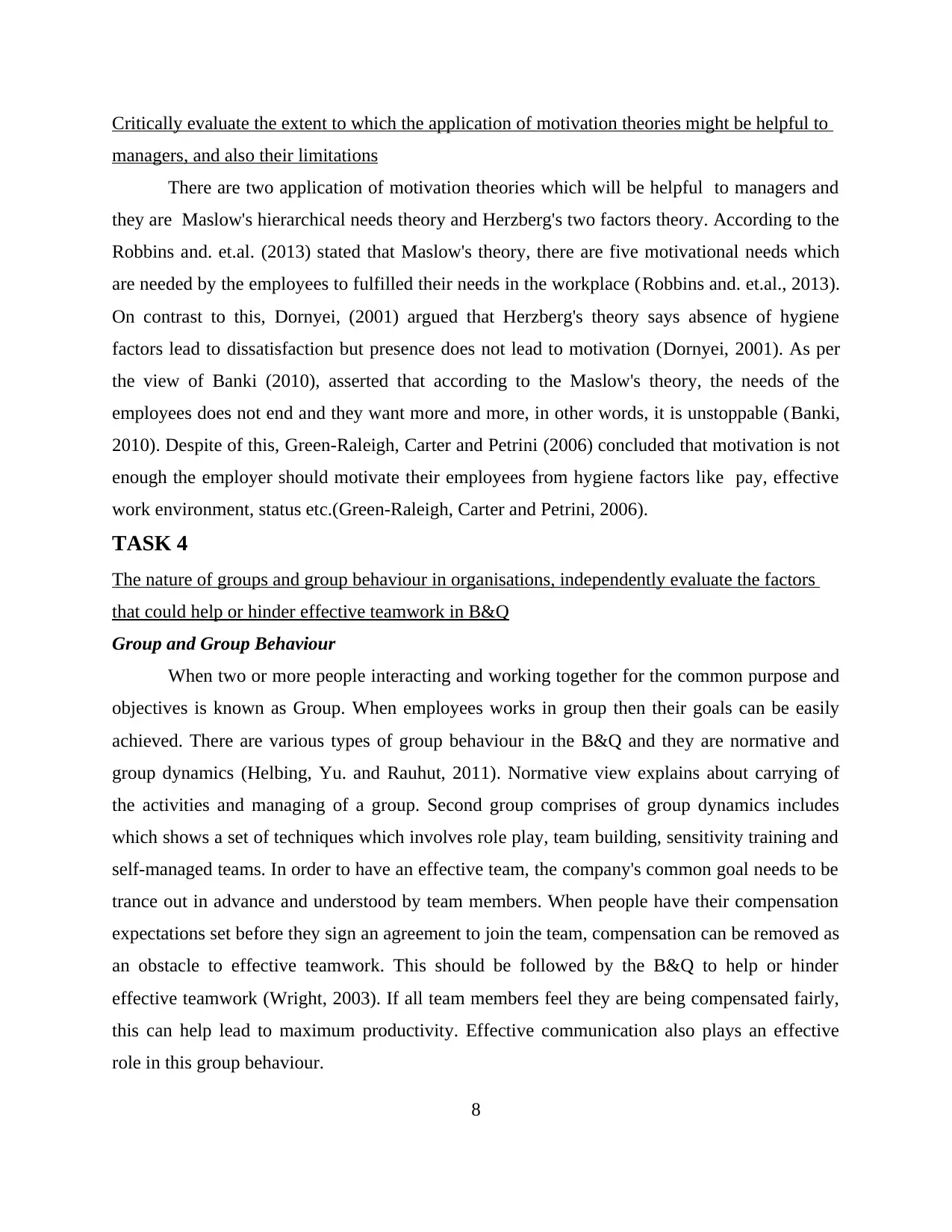
Critically evaluate the extent to which the application of motivation theories might be helpful to
managers, and also their limitations
There are two application of motivation theories which will be helpful to managers and
they are Maslow's hierarchical needs theory and Herzberg's two factors theory. According to the
Robbins and. et.al. (2013) stated that Maslow's theory, there are five motivational needs which
are needed by the employees to fulfilled their needs in the workplace (Robbins and. et.al., 2013).
On contrast to this, Dornyei, (2001) argued that Herzberg's theory says absence of hygiene
factors lead to dissatisfaction but presence does not lead to motivation (Dornyei, 2001). As per
the view of Banki (2010), asserted that according to the Maslow's theory, the needs of the
employees does not end and they want more and more, in other words, it is unstoppable (Banki,
2010). Despite of this, Green-Raleigh, Carter and Petrini (2006) concluded that motivation is not
enough the employer should motivate their employees from hygiene factors like pay, effective
work environment, status etc.(Green-Raleigh, Carter and Petrini, 2006).
TASK 4
The nature of groups and group behaviour in organisations, independently evaluate the factors
that could help or hinder effective teamwork in B&Q
Group and Group Behaviour
When two or more people interacting and working together for the common purpose and
objectives is known as Group. When employees works in group then their goals can be easily
achieved. There are various types of group behaviour in the B&Q and they are normative and
group dynamics (Helbing, Yu. and Rauhut, 2011). Normative view explains about carrying of
the activities and managing of a group. Second group comprises of group dynamics includes
which shows a set of techniques which involves role play, team building, sensitivity training and
self-managed teams. In order to have an effective team, the company's common goal needs to be
trance out in advance and understood by team members. When people have their compensation
expectations set before they sign an agreement to join the team, compensation can be removed as
an obstacle to effective teamwork. This should be followed by the B&Q to help or hinder
effective teamwork (Wright, 2003). If all team members feel they are being compensated fairly,
this can help lead to maximum productivity. Effective communication also plays an effective
role in this group behaviour.
8
managers, and also their limitations
There are two application of motivation theories which will be helpful to managers and
they are Maslow's hierarchical needs theory and Herzberg's two factors theory. According to the
Robbins and. et.al. (2013) stated that Maslow's theory, there are five motivational needs which
are needed by the employees to fulfilled their needs in the workplace (Robbins and. et.al., 2013).
On contrast to this, Dornyei, (2001) argued that Herzberg's theory says absence of hygiene
factors lead to dissatisfaction but presence does not lead to motivation (Dornyei, 2001). As per
the view of Banki (2010), asserted that according to the Maslow's theory, the needs of the
employees does not end and they want more and more, in other words, it is unstoppable (Banki,
2010). Despite of this, Green-Raleigh, Carter and Petrini (2006) concluded that motivation is not
enough the employer should motivate their employees from hygiene factors like pay, effective
work environment, status etc.(Green-Raleigh, Carter and Petrini, 2006).
TASK 4
The nature of groups and group behaviour in organisations, independently evaluate the factors
that could help or hinder effective teamwork in B&Q
Group and Group Behaviour
When two or more people interacting and working together for the common purpose and
objectives is known as Group. When employees works in group then their goals can be easily
achieved. There are various types of group behaviour in the B&Q and they are normative and
group dynamics (Helbing, Yu. and Rauhut, 2011). Normative view explains about carrying of
the activities and managing of a group. Second group comprises of group dynamics includes
which shows a set of techniques which involves role play, team building, sensitivity training and
self-managed teams. In order to have an effective team, the company's common goal needs to be
trance out in advance and understood by team members. When people have their compensation
expectations set before they sign an agreement to join the team, compensation can be removed as
an obstacle to effective teamwork. This should be followed by the B&Q to help or hinder
effective teamwork (Wright, 2003). If all team members feel they are being compensated fairly,
this can help lead to maximum productivity. Effective communication also plays an effective
role in this group behaviour.
8
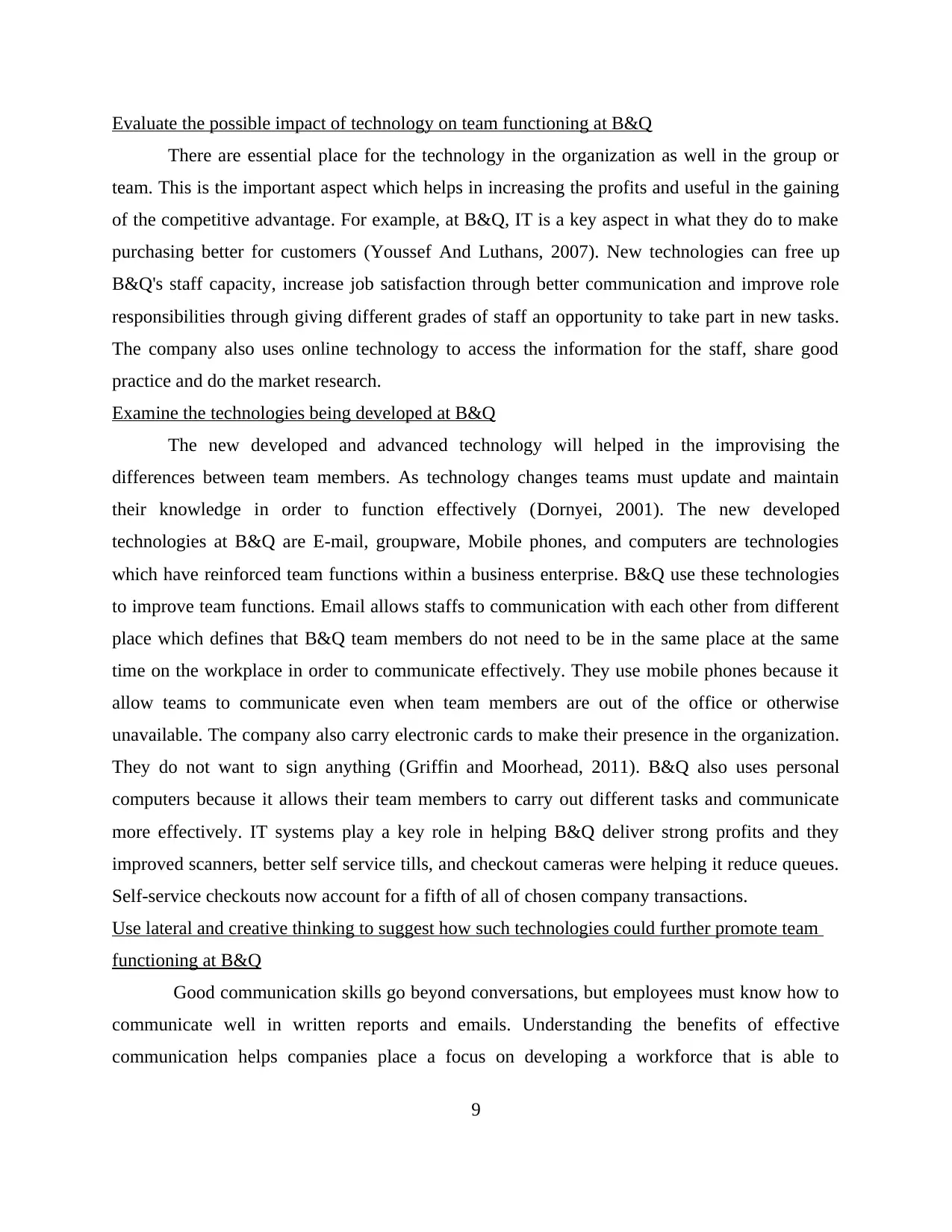
Evaluate the possible impact of technology on team functioning at B&Q
There are essential place for the technology in the organization as well in the group or
team. This is the important aspect which helps in increasing the profits and useful in the gaining
of the competitive advantage. For example, at B&Q, IT is a key aspect in what they do to make
purchasing better for customers (Youssef And Luthans, 2007). New technologies can free up
B&Q's staff capacity, increase job satisfaction through better communication and improve role
responsibilities through giving different grades of staff an opportunity to take part in new tasks.
The company also uses online technology to access the information for the staff, share good
practice and do the market research.
Examine the technologies being developed at B&Q
The new developed and advanced technology will helped in the improvising the
differences between team members. As technology changes teams must update and maintain
their knowledge in order to function effectively (Dornyei, 2001). The new developed
technologies at B&Q are E-mail, groupware, Mobile phones, and computers are technologies
which have reinforced team functions within a business enterprise. B&Q use these technologies
to improve team functions. Email allows staffs to communication with each other from different
place which defines that B&Q team members do not need to be in the same place at the same
time on the workplace in order to communicate effectively. They use mobile phones because it
allow teams to communicate even when team members are out of the office or otherwise
unavailable. The company also carry electronic cards to make their presence in the organization.
They do not want to sign anything (Griffin and Moorhead, 2011). B&Q also uses personal
computers because it allows their team members to carry out different tasks and communicate
more effectively. IT systems play a key role in helping B&Q deliver strong profits and they
improved scanners, better self service tills, and checkout cameras were helping it reduce queues.
Self-service checkouts now account for a fifth of all of chosen company transactions.
Use lateral and creative thinking to suggest how such technologies could further promote team
functioning at B&Q
Good communication skills go beyond conversations, but employees must know how to
communicate well in written reports and emails. Understanding the benefits of effective
communication helps companies place a focus on developing a workforce that is able to
9
There are essential place for the technology in the organization as well in the group or
team. This is the important aspect which helps in increasing the profits and useful in the gaining
of the competitive advantage. For example, at B&Q, IT is a key aspect in what they do to make
purchasing better for customers (Youssef And Luthans, 2007). New technologies can free up
B&Q's staff capacity, increase job satisfaction through better communication and improve role
responsibilities through giving different grades of staff an opportunity to take part in new tasks.
The company also uses online technology to access the information for the staff, share good
practice and do the market research.
Examine the technologies being developed at B&Q
The new developed and advanced technology will helped in the improvising the
differences between team members. As technology changes teams must update and maintain
their knowledge in order to function effectively (Dornyei, 2001). The new developed
technologies at B&Q are E-mail, groupware, Mobile phones, and computers are technologies
which have reinforced team functions within a business enterprise. B&Q use these technologies
to improve team functions. Email allows staffs to communication with each other from different
place which defines that B&Q team members do not need to be in the same place at the same
time on the workplace in order to communicate effectively. They use mobile phones because it
allow teams to communicate even when team members are out of the office or otherwise
unavailable. The company also carry electronic cards to make their presence in the organization.
They do not want to sign anything (Griffin and Moorhead, 2011). B&Q also uses personal
computers because it allows their team members to carry out different tasks and communicate
more effectively. IT systems play a key role in helping B&Q deliver strong profits and they
improved scanners, better self service tills, and checkout cameras were helping it reduce queues.
Self-service checkouts now account for a fifth of all of chosen company transactions.
Use lateral and creative thinking to suggest how such technologies could further promote team
functioning at B&Q
Good communication skills go beyond conversations, but employees must know how to
communicate well in written reports and emails. Understanding the benefits of effective
communication helps companies place a focus on developing a workforce that is able to
9
⊘ This is a preview!⊘
Do you want full access?
Subscribe today to unlock all pages.

Trusted by 1+ million students worldwide
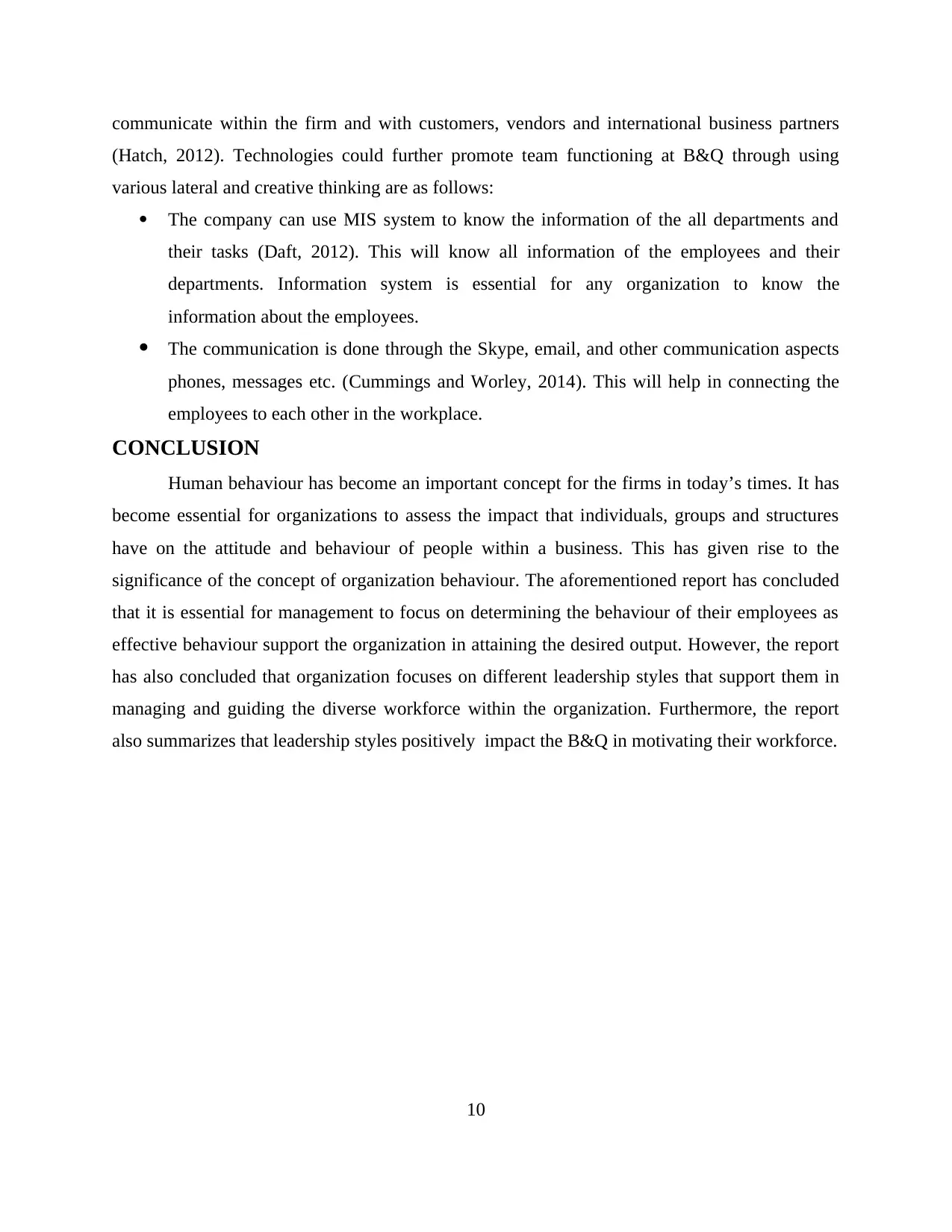
communicate within the firm and with customers, vendors and international business partners
(Hatch, 2012). Technologies could further promote team functioning at B&Q through using
various lateral and creative thinking are as follows:
The company can use MIS system to know the information of the all departments and
their tasks (Daft, 2012). This will know all information of the employees and their
departments. Information system is essential for any organization to know the
information about the employees.
The communication is done through the Skype, email, and other communication aspects
phones, messages etc. (Cummings and Worley, 2014). This will help in connecting the
employees to each other in the workplace.
CONCLUSION
Human behaviour has become an important concept for the firms in today’s times. It has
become essential for organizations to assess the impact that individuals, groups and structures
have on the attitude and behaviour of people within a business. This has given rise to the
significance of the concept of organization behaviour. The aforementioned report has concluded
that it is essential for management to focus on determining the behaviour of their employees as
effective behaviour support the organization in attaining the desired output. However, the report
has also concluded that organization focuses on different leadership styles that support them in
managing and guiding the diverse workforce within the organization. Furthermore, the report
also summarizes that leadership styles positively impact the B&Q in motivating their workforce.
10
(Hatch, 2012). Technologies could further promote team functioning at B&Q through using
various lateral and creative thinking are as follows:
The company can use MIS system to know the information of the all departments and
their tasks (Daft, 2012). This will know all information of the employees and their
departments. Information system is essential for any organization to know the
information about the employees.
The communication is done through the Skype, email, and other communication aspects
phones, messages etc. (Cummings and Worley, 2014). This will help in connecting the
employees to each other in the workplace.
CONCLUSION
Human behaviour has become an important concept for the firms in today’s times. It has
become essential for organizations to assess the impact that individuals, groups and structures
have on the attitude and behaviour of people within a business. This has given rise to the
significance of the concept of organization behaviour. The aforementioned report has concluded
that it is essential for management to focus on determining the behaviour of their employees as
effective behaviour support the organization in attaining the desired output. However, the report
has also concluded that organization focuses on different leadership styles that support them in
managing and guiding the diverse workforce within the organization. Furthermore, the report
also summarizes that leadership styles positively impact the B&Q in motivating their workforce.
10
Paraphrase This Document
Need a fresh take? Get an instant paraphrase of this document with our AI Paraphraser
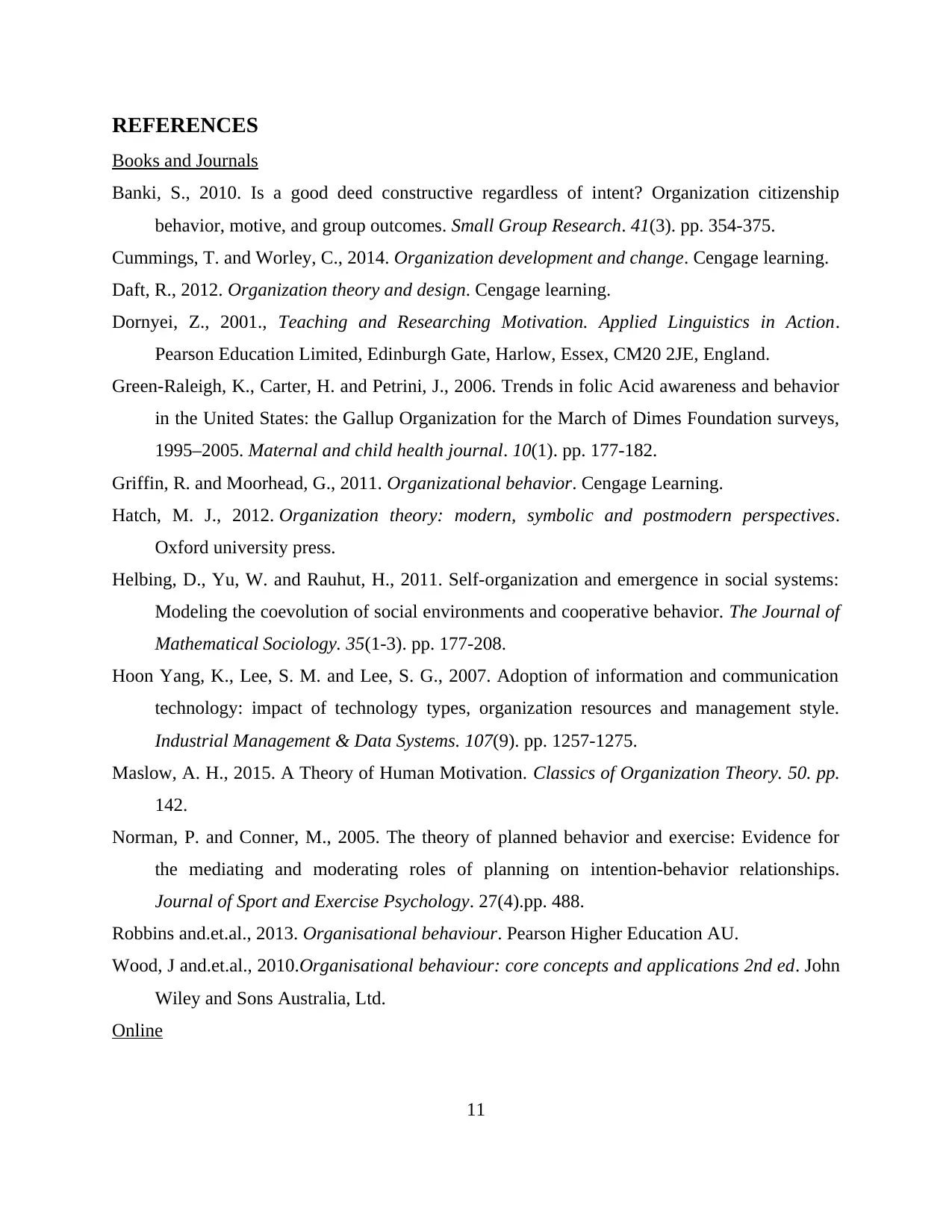
REFERENCES
Books and Journals
Banki, S., 2010. Is a good deed constructive regardless of intent? Organization citizenship
behavior, motive, and group outcomes. Small Group Research. 41(3). pp. 354-375.
Cummings, T. and Worley, C., 2014. Organization development and change. Cengage learning.
Daft, R., 2012. Organization theory and design. Cengage learning.
Dornyei, Z., 2001., Teaching and Researching Motivation. Applied Linguistics in Action.
Pearson Education Limited, Edinburgh Gate, Harlow, Essex, CM20 2JE, England.
Green-Raleigh, K., Carter, H. and Petrini, J., 2006. Trends in folic Acid awareness and behavior
in the United States: the Gallup Organization for the March of Dimes Foundation surveys,
1995–2005. Maternal and child health journal. 10(1). pp. 177-182.
Griffin, R. and Moorhead, G., 2011. Organizational behavior. Cengage Learning.
Hatch, M. J., 2012. Organization theory: modern, symbolic and postmodern perspectives.
Oxford university press.
Helbing, D., Yu, W. and Rauhut, H., 2011. Self-organization and emergence in social systems:
Modeling the coevolution of social environments and cooperative behavior. The Journal of
Mathematical Sociology. 35(1-3). pp. 177-208.
Hoon Yang, K., Lee, S. M. and Lee, S. G., 2007. Adoption of information and communication
technology: impact of technology types, organization resources and management style.
Industrial Management & Data Systems. 107(9). pp. 1257-1275.
Maslow, A. H., 2015. A Theory of Human Motivation. Classics of Organization Theory. 50. pp.
142.
Norman, P. and Conner, M., 2005. The theory of planned behavior and exercise: Evidence for
the mediating and moderating roles of planning on intention-behavior relationships.
Journal of Sport and Exercise Psychology. 27(4).pp. 488.
Robbins and.et.al., 2013. Organisational behaviour. Pearson Higher Education AU.
Wood, J and.et.al., 2010.Organisational behaviour: core concepts and applications 2nd ed. John
Wiley and Sons Australia, Ltd.
Online
11
Books and Journals
Banki, S., 2010. Is a good deed constructive regardless of intent? Organization citizenship
behavior, motive, and group outcomes. Small Group Research. 41(3). pp. 354-375.
Cummings, T. and Worley, C., 2014. Organization development and change. Cengage learning.
Daft, R., 2012. Organization theory and design. Cengage learning.
Dornyei, Z., 2001., Teaching and Researching Motivation. Applied Linguistics in Action.
Pearson Education Limited, Edinburgh Gate, Harlow, Essex, CM20 2JE, England.
Green-Raleigh, K., Carter, H. and Petrini, J., 2006. Trends in folic Acid awareness and behavior
in the United States: the Gallup Organization for the March of Dimes Foundation surveys,
1995–2005. Maternal and child health journal. 10(1). pp. 177-182.
Griffin, R. and Moorhead, G., 2011. Organizational behavior. Cengage Learning.
Hatch, M. J., 2012. Organization theory: modern, symbolic and postmodern perspectives.
Oxford university press.
Helbing, D., Yu, W. and Rauhut, H., 2011. Self-organization and emergence in social systems:
Modeling the coevolution of social environments and cooperative behavior. The Journal of
Mathematical Sociology. 35(1-3). pp. 177-208.
Hoon Yang, K., Lee, S. M. and Lee, S. G., 2007. Adoption of information and communication
technology: impact of technology types, organization resources and management style.
Industrial Management & Data Systems. 107(9). pp. 1257-1275.
Maslow, A. H., 2015. A Theory of Human Motivation. Classics of Organization Theory. 50. pp.
142.
Norman, P. and Conner, M., 2005. The theory of planned behavior and exercise: Evidence for
the mediating and moderating roles of planning on intention-behavior relationships.
Journal of Sport and Exercise Psychology. 27(4).pp. 488.
Robbins and.et.al., 2013. Organisational behaviour. Pearson Higher Education AU.
Wood, J and.et.al., 2010.Organisational behaviour: core concepts and applications 2nd ed. John
Wiley and Sons Australia, Ltd.
Online
11
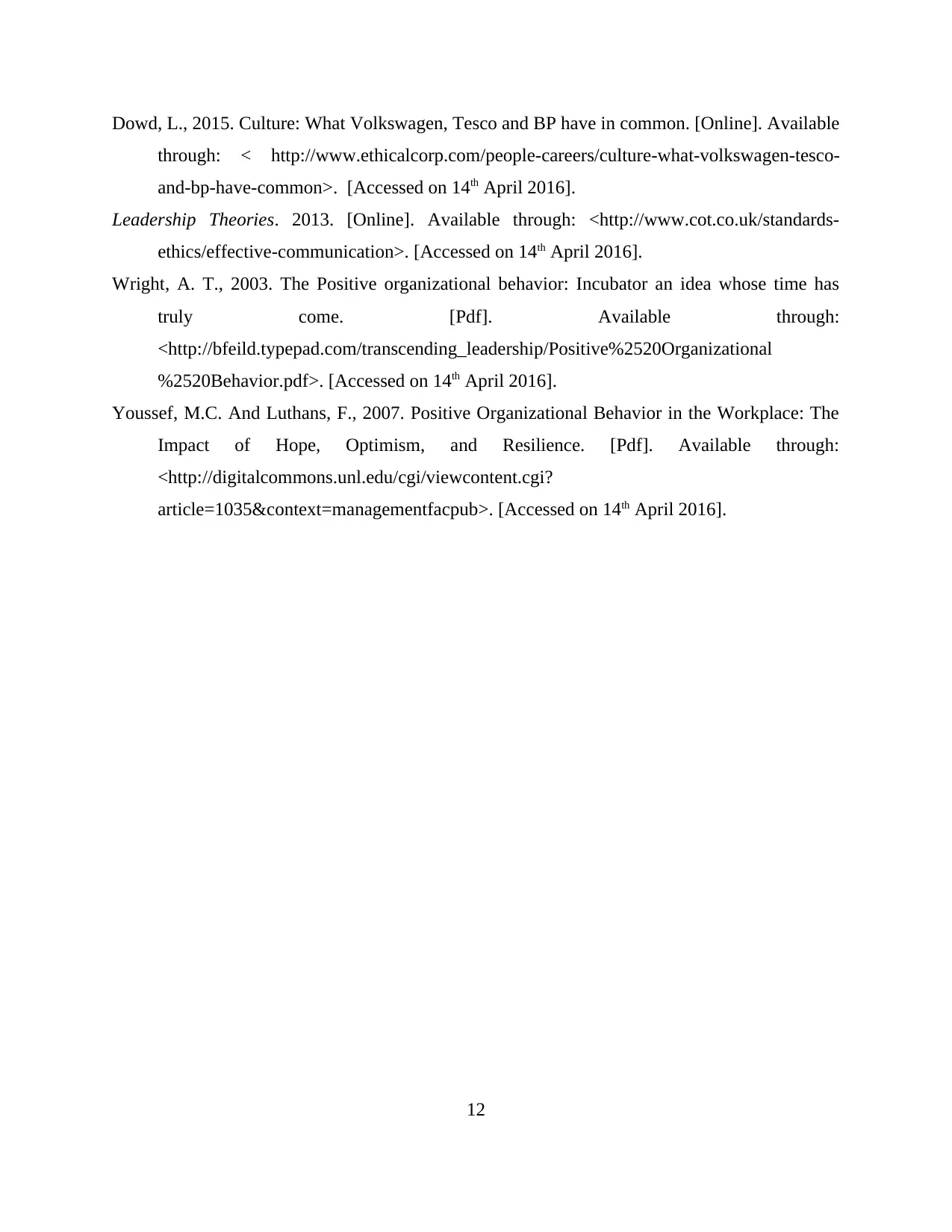
Dowd, L., 2015. Culture: What Volkswagen, Tesco and BP have in common. [Online]. Available
through: < http://www.ethicalcorp.com/people-careers/culture-what-volkswagen-tesco-
and-bp-have-common>. [Accessed on 14th April 2016].
Leadership Theories. 2013. [Online]. Available through: <http://www.cot.co.uk/standards-
ethics/effective-communication>. [Accessed on 14th April 2016].
Wright, A. T., 2003. The Positive organizational behavior: Incubator an idea whose time has
truly come. [Pdf]. Available through:
<http://bfeild.typepad.com/transcending_leadership/Positive%2520Organizational
%2520Behavior.pdf>. [Accessed on 14th April 2016].
Youssef, M.C. And Luthans, F., 2007. Positive Organizational Behavior in the Workplace: The
Impact of Hope, Optimism, and Resilience. [Pdf]. Available through:
<http://digitalcommons.unl.edu/cgi/viewcontent.cgi?
article=1035&context=managementfacpub>. [Accessed on 14th April 2016].
12
through: < http://www.ethicalcorp.com/people-careers/culture-what-volkswagen-tesco-
and-bp-have-common>. [Accessed on 14th April 2016].
Leadership Theories. 2013. [Online]. Available through: <http://www.cot.co.uk/standards-
ethics/effective-communication>. [Accessed on 14th April 2016].
Wright, A. T., 2003. The Positive organizational behavior: Incubator an idea whose time has
truly come. [Pdf]. Available through:
<http://bfeild.typepad.com/transcending_leadership/Positive%2520Organizational
%2520Behavior.pdf>. [Accessed on 14th April 2016].
Youssef, M.C. And Luthans, F., 2007. Positive Organizational Behavior in the Workplace: The
Impact of Hope, Optimism, and Resilience. [Pdf]. Available through:
<http://digitalcommons.unl.edu/cgi/viewcontent.cgi?
article=1035&context=managementfacpub>. [Accessed on 14th April 2016].
12
⊘ This is a preview!⊘
Do you want full access?
Subscribe today to unlock all pages.

Trusted by 1+ million students worldwide
1 out of 12
Related Documents
Your All-in-One AI-Powered Toolkit for Academic Success.
+13062052269
info@desklib.com
Available 24*7 on WhatsApp / Email
![[object Object]](/_next/static/media/star-bottom.7253800d.svg)
Unlock your academic potential
Copyright © 2020–2025 A2Z Services. All Rights Reserved. Developed and managed by ZUCOL.





